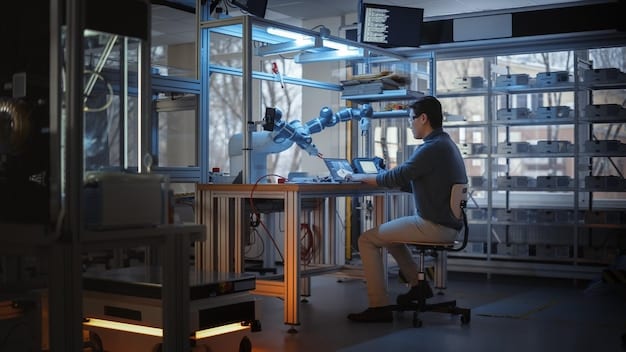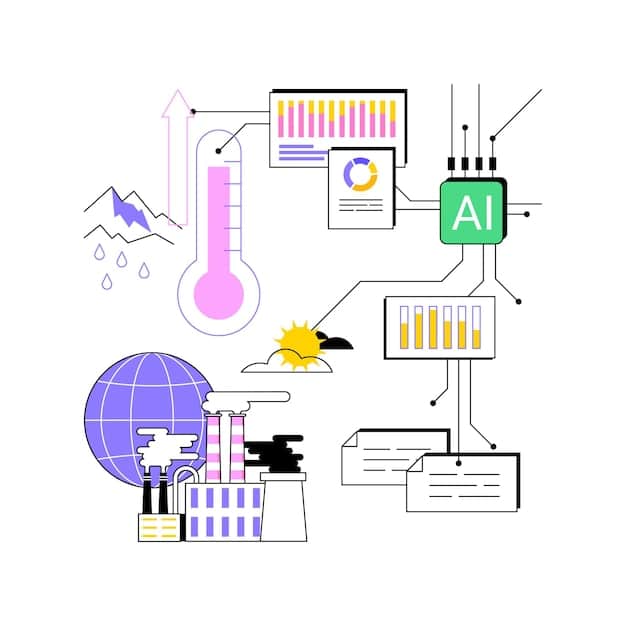US Government’s $2B AI Initiative: Funding & Focus Areas

The US government has launched a $2 billion initiative to significantly boost artificial intelligence (AI) research and development. This investment aims to drive innovation across several key areas, including next-generation AI, climate change solutions, and advancements in healthcare, ensuring the US remains competitive in the global AI landscape and addresses critical national challenges.
The US government is making a significant move to bolster its position in the artificial intelligence (AI) arena with a newly announced $2 billion initiative. This comprehensive effort is designed to accelerate AI research and development, targeting crucial sectors and ensuring American leadership in this rapidly evolving field.
US Government’s $2 Billion AI Initiative: A Closer Look
The $2 billion initiative represents a substantial commitment to advancing AI technologies. This investment is not just about pouring money into research; it’s a strategic move to foster innovation, create jobs, and address some of the most pressing challenges facing the nation. The initiative spans multiple government agencies and focuses on a diverse range of projects.
This initiative is expected to have a cascading effect, stimulating growth in both the public and private sectors. It will create opportunities for researchers, entrepreneurs, and businesses to collaborate and develop cutting-edge AI solutions. The government’s role is to provide the necessary infrastructure and funding to ensure these innovations can thrive.

Key Objectives of the Initiative
Several key objectives underpin the US government’s $2 billion AI initiative. These objectives guide the allocation of funds and ensure that the research and development efforts are aligned with national priorities.
- Advancing Next-Generation AI: Developing AI technologies that are more robust, explainable, and ethical.
- Addressing Climate Change: Utilizing AI to model climate patterns, optimize energy consumption, and develop sustainable solutions.
- Improving Healthcare: Leveraging AI to enhance diagnostics, personalize treatments, and improve patient outcomes.
- Enhancing National Security: Applying AI to cybersecurity, threat detection, and defense systems.
These objectives reflect a broad understanding of AI’s potential to transform various sectors. The government recognizes that AI is not just a technological tool but a strategic asset that can be used to address some of the most pressing challenges facing the nation.
In conclusion, the US government’s $2 billion AI initiative is a multifaceted effort aimed at advancing AI technologies across various sectors. By focusing on key objectives such as climate change and health initiatives, along with the other goals outlined, the initiative seeks to ensure the US remains competitive in the global AI landscape.
Focus Areas of AI Research and Development
The $2 billion AI initiative is strategically channeled into several key focus areas, each designed to leverage AI’s transformative potential. These areas are not mutually exclusive; in fact, many projects will likely overlap and integrate various aspects of AI research and development.
These specific focus areas reflect the government’s understanding of AI’s broad applicability. By targeting these sectors, the initiative aims to maximize its impact and ensure that the US remains at the forefront of AI innovation.
Healthcare Advancements
AI holds immense promise for revolutionizing healthcare, from improving diagnostics to personalizing treatments. The initiative will fund projects that explore AI’s potential to enhance patient outcomes and reduce healthcare costs.
AI can analyze medical images with greater accuracy and speed than human radiologists, leading to earlier and more accurate diagnoses. It can also personalize treatment plans based on a patient’s genetic makeup, lifestyle, and medical history.
Climate Change Solutions
Climate change is one of the most pressing challenges facing the world, and AI can play a crucial role in developing sustainable solutions. The initiative will support research into AI-powered tools for monitoring climate patterns, optimizing energy consumption, and developing renewable energy sources.
AI algorithms can analyze vast amounts of climate data to identify patterns and predict future trends, helping policymakers make informed decisions. AI can also optimize energy grids to reduce waste and improve efficiency.

Cybersecurity and National Security
As cyber threats become more sophisticated, AI can provide a critical defense against attacks. The initiative will fund research into AI-powered cybersecurity systems that can detect and respond to threats in real-time.
AI algorithms can analyze network traffic to identify anomalies and detect malicious activity. AI can also automate threat responses, allowing security teams to react more quickly and effectively to attacks. Similarly, AI can improve situational awareness for military personnel, enhancing decision-making in tactical environments.
To summarise, the US government’s AI initiative identifies healthcare improvements, environmental solutions, and cybersecurity enhancements as vital focal points in advancing AI technology. This strategic approach ensures that the funding is funneled towards projects that address pressing national challenges and has the potential to improve safety, health, and security across the nation.
Funding Opportunities and Grant Programs
The $2 billion AI initiative will be distributed through various funding opportunities and grant programs, managed by different government agencies. These programs are designed to attract a diverse range of applicants, from academic researchers to small businesses and large corporations.
Understanding the different funding opportunities and grant programs is essential for anyone interested in participating in the AI initiative. By tailoring their applications to the specific requirements of each program, applicants can increase their chances of success.
National Science Foundation (NSF)
The NSF is a major source of funding for basic research in AI and related fields. It offers a variety of grant programs that support research projects, education and training initiatives, and infrastructure development.
NSF grants are highly competitive, but they provide significant funding for researchers at universities and other institutions. The NSF also supports collaborative projects that bring together researchers from different disciplines and institutions.
Department of Energy (DOE)
The DOE is focused on using AI to address energy-related challenges, such as optimizing energy consumption, developing renewable energy sources, and improving grid reliability. It offers funding opportunities for research projects, technology demonstrations, and pilot programs.
DOE funding is often targeted at projects that have the potential to make a significant impact on energy efficiency and sustainability. The DOE also supports projects that involve partnerships between government, industry, and academia.
National Institutes of Health (NIH)
The NIH is the primary federal agency responsible for biomedical research. It offers a variety of grant programs that support research into AI applications in healthcare, such as improving diagnostics, personalizing treatments, and developing new therapies.
NIH funding is often focused on projects that have the potential to improve human health and well-being. The NIH also supports projects that involve collaborations between researchers and clinicians.
In short, the funding opportunities related to the US Government’s new AI initiative are diverse and spread across numerous agencies, each with its own focus and scope. Understanding the specifics for each program can aid researchers and institutions in preparing a targeted and successful application.
Impact on the AI Ecosystem and Job Creation
The $2 billion AI initiative is expected to have a significant impact on the AI ecosystem, stimulating innovation, fostering collaboration, and creating jobs. The initiative will support research and development activities across a wide range of sectors, leading to the creation of new products, services, and business models.
The long-term impact of the AI initiative is likely to be transformative. By investing in AI research and development, the government is laying the foundation for a future in which AI plays a central role in all aspects of society.
Stimulating Innovation
The AI initiative will provide funding for researchers, entrepreneurs, and businesses to develop cutting-edge AI technologies. This will lead to a wave of innovation, as new ideas are explored and new solutions are developed.
The initiative will also foster collaboration between different organizations, as researchers from universities, government agencies, and private companies work together to solve complex problems. This collaboration will accelerate the pace of innovation and ensure that new technologies are rapidly deployed.
Fostering Collaboration
The AI initiative emphasizes the importance of collaboration between different stakeholders. It encourages researchers, entrepreneurs, and businesses to work together to develop and deploy AI technologies.
This collaboration will help to ensure that AI technologies are developed in a way that is responsible, ethical, and aligned with societal values. It will also help to ensure that the benefits of AI are widely shared.
- Increased funding for AI research and development.
- Creation of new AI-related businesses and jobs.
- Attraction of top AI talent to the United States.
- Development of innovative AI solutions for various sectors.
The initiative has the potential to transform the American economy and society. By investing in AI, the Government is laying the foundation for a future in which everyone has access to good jobs and meaningful opportunities.
Ultimately, the US government’s venture into AI promises tremendous improvements in both the AI arena and the amount of jobs created for interested parties. Investment in innovative AI technologies can increase productivity and efficiency in various industries, leading to economic prosperity and, again, an improved standard of living.
Ensuring Ethical and Responsible AI Development
As AI technologies become more powerful and pervasive, it is essential to ensure that they are developed and used in a way that is ethical and responsible. The $2 billion AI initiative recognizes this need and includes provisions for addressing ethical and societal implications of AI.
These provisions reflect a commitment to ensuring that AI technologies are used for good and that their potential harms are minimized. By prioritizing ethics and responsibility, the initiative aims to build public trust in AI and promote its widespread adoption.
Addressing Bias and Discrimination
AI algorithms can perpetuate and amplify existing biases in data, leading to discriminatory outcomes. The initiative will fund research into methods for mitigating bias in AI algorithms and ensuring that they are fair and equitable.
This research will involve developing new techniques for data analysis, algorithm design, and evaluation. It will also involve engaging with communities that are disproportionately affected by bias in AI to understand their concerns and develop solutions that meet their needs.
Promoting Transparency and Explainability
Many AI algorithms are opaque, making it difficult to understand how they make decisions. This lack of transparency can undermine trust and make it difficult to identify and correct errors. The initiative will fund research into methods for making AI algorithms more transparent and explainable.
This research will involve developing new techniques for visualizing and interpreting AI algorithms. It will also involve developing new methods for explaining AI decisions to users, so that they can understand why a particular outcome was reached.
- Establishment of ethical guidelines for AI development and deployment.
- Development of tools and techniques for mitigating bias in AI algorithms.
- Promotion of transparency and explainability in AI decision-making.
- Engagement with the public to build trust in AI.
These measures will help to ensure that AI technologies are used in a way that aligns with public values and promotes social good.
In sum, this section aims to guarantee the development of AI is ethically sound, and is free from potential biases that can negatively affect different parts of the population. This promotes trust between the AI tech and the general public, increasing the chance of positive results.
International Collaboration and Global Competitiveness
AI is a global technology, and international collaboration is essential for advancing the field and ensuring that the benefits of AI are widely shared. The $2 billion AI initiative recognizes the importance of international collaboration and includes provisions for promoting partnerships with other countries.
These partnerships will enable the US to leverage the expertise and resources of researchers and institutions around the world. They will also help to ensure that AI technologies are developed in a way that is aligned with global values and norms.
Promoting Knowledge Sharing
The initiative may support international conferences, workshops, and exchanges to promote knowledge sharing and collaboration between researchers from different countries.
These activities will help to disseminate new ideas, identify best practices, and foster a global community of AI researchers.
Supporting Joint Research Projects
The program also encourages the creation of joint research projects between American researchers and their counterparts in other countries. These projects will address complex problems that require expertise from multiple disciplines and perspectives.
They will also provide opportunities for researchers to learn from each other and develop new skills.
- Engagement in international forums and initiatives on AI.
- Support for collaborative research projects with international partners.
- Promotion of knowledge sharing and best practices in AI.
- Alignment with international standards and norms for AI.
These measures will help to ensure that the US remains a leader in AI and that the benefits of AI are widely shared around the world.
To close, fostering international collaborations can allow for an international exchange of ideas and expertise, leading to great innovation in the field of AI. This helps to ensure the US remains at the forefront of AI innovation, making it a global leader in the tech sector.
| Key Point | Brief Description |
|---|---|
| 🚀 Funding Boost | $2 billion allocated to AI research and development. |
| 🏥 Healthcare AI | Improving diagnostics, treatments, and patient care with AI. |
| 🌍 Climate Solutions | AI tools for climate modeling and sustainable energy. |
| 🛡️ Cyber Security | Enhancing cybersecurity with real-time threat detection AI. |
Frequently Asked Questions (FAQ)
▼
The primary goal is to significantly boost AI research and development in the US, ensuring the nation remains competitive and advances AI technologies in key sectors like healthcare, climate change, and national security.
▼
Healthcare is expected to benefit immensely through AI-enhanced diagnostics and treatment plans. Other sectors include climate change, national security, and energy, where AI can model and improve existing processes.
▼
Funding will be allocated through various grant programs managed by agencies such as the NSF, DOE, and NIH, each focusing on projects that align with their specific mandates and strategic goals for AI development.
▼
The initiative addresses ethical considerations by promoting transparency, accountability, and fairness in AI systems. These measures include research into mitigating bias and ensuring ethical standards are upheld during development.
▼
The initiative actively encourages worldwide collaboration through projects, exchanges, and conferences, and will support sharing ideas and expertise. This fosters the development of global norms for AI technologies.
Conclusion
The US government’s $2 billion initiative marks a pivotal step towards solidifying its leadership in AI. By targeting key sectors and encouraging collaboration, this investment promises to drive innovation and deliver tangible benefits to society.





